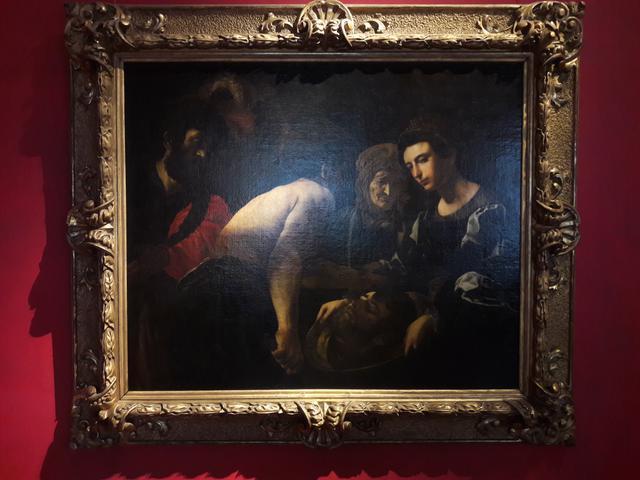Salome

Battistello was a 17th century Neapolitan artist who adhered to the artistic language of Caravaggio. His painting Salomè recounts the horrible episode of the beheading of the Baptist that Herod's beautiful stepdaughter wanted.
Salomè holds in her hands, firmly in place, the large silver plate, chiseled at the edges, on which the head of the Baptist is given. A young man, painted on his back, bare-chested, wearing only a pair of large pants, holds his decapitated head by clutching his hair with his left hand. With his right hand, however, he still holds the sword used for beheading. Between the two figures, an old woman, dressed in 17th century clothing, observes the head of the suffering Baptist. On the left, partially cut from the edge of the painting, a middle-aged man is depicted. His face is framed by a thick dark beard. His clothes are elegant and he wears a hat with feathers.
The story of Salome is told in the gospels of Mark and Matthew. The young Jewish princess was the daughter of Herodias and Herod Philip I. The mother, Herodias, left her husband to join Herod Antipas. The king welcomed mother and daughter and showed a strong attraction for the young woman. Meanwhile, Giovanni Battista, during his public sermons, condemned the amoral behavior of the king who imprisoned him for this. Herodias was very upset, worried about the Baptist's influence on the people, she took the opportunity to eliminate him forever.
During a banquet, Salome performed a provocative dance in the presence of Herod Antipas. In the end, the admired king asked the young woman to choose the gift she wanted. At the suggestion of her mother Herodias, the girl asked for the Baptist's head. Herod Antipas, although he feared the reproach of the people, had the sentence carried out and gave the head of the Saint on a silver plate to his stepdaughter.
The Battistello was formed in Naples within the Counter-Reformation Mannerism represented by some local masters such as Belisario Coducci, Fabrizio Santafede and Francesco Imparato. However, it was after Caravaggio's presence in Naples, from 1607 and the works present in the master's city, that he adhered to the new language. The background of Salomè's scene is dark and deep and the figures emerge from it, illuminated directionally.
The light, almost pastoral, highlights the bodies and faces and helps narrate the event. The Baptist's head, in fact, is in shadow, as is the face of his artist. This choice is also found in the Crucifixion of San Pietro del Caravaggio. Salomé, on the other hand, is almost completely illuminated. Even her dress is described very carefully. The fabric, which creates an elaborate curtain on the left shoulder, is in fact illuminated with a very descriptive light. This greater attention to the figure of the young woman also transforms her figure into a portrait of herself, isolated, almost, from the rest of the scene.
© Tourblink